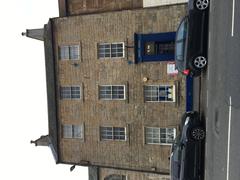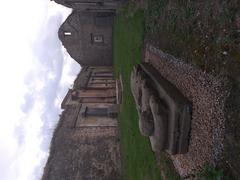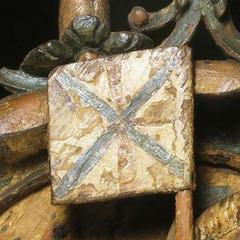Hermand Brick and Tile Works Livingston: Visiting Hours, Tickets, and Historical Sites Guide
Date: 14/06/2025
Introduction
Situated near West Calder and Livingston in West Lothian, Scotland, Hermand Brick & Tile Works is a prominent testament to the region’s industrial history. Established before 1882, this site was a major center for brick and tile manufacturing, leveraging the area’s rich deposits of fireclay and coal. Hermand’s products, including highly valued fire bricks, contributed significantly to Scotland’s industrial infrastructure and architecture, especially supporting the growth of the shale oil sector.
Today, Hermand Brick & Tile Works is an evocative open-air heritage site, free to access year-round. Visitors can explore the remnants of its industrial past—kiln bases, clay pits, and scattered bricks—while enjoying the scenic landscape. Proximity to attractions such as Almond Valley Heritage Centre and the historic village of West Calder further enriches the visitor experience. This guide provides all you need to plan your visit, with details on site history, accessibility, travel tips, and nearby attractions. For additional resources and updates, refer to Scottish Brick History and the official Visit West Lothian website.
Table of Contents
- Overview and Historical Significance
- Visiting Information
- What to See and Do
- Getting There and Travel Tips
- Nearby Attractions
- Visitor Safety and Responsible Tourism
- Frequently Asked Questions (FAQ)
- Further Resources and References
- Conclusion
Overview and Historical Significance
Hermand Brick & Tile Works began operations prior to 1882, reaching peak production in the late 19th century under the stewardship of G.S. Loudon and, later, John B. Walker. The works produced up to 10,000 bricks daily, including fire bricks essential for industrial furnaces, and later diversified into agricultural pipes and decorative items. The brickworks were integral to the development of West Lothian, supporting the local economy and providing materials for Scotland’s industrial and urban expansion.
After its closure, the site was gradually reclaimed by nature, but the remaining foundations and brick fragments serve as enduring reminders of the area’s industrial ingenuity. Hermand’s legacy reflects not only technological and economic progress but also the resilience of the communities shaped by this industry (Scottish Brick History; IntechOpen).
Visiting Information
Location
Hermand Brick & Tile Works is located near West Calder, close to Livingston in West Lothian, Scotland. It is easily accessible by road and public transport, and lies within reach of both Edinburgh and Glasgow.
Opening Hours
- The site is open to the public year-round.
- There are no gates or formal opening times; access is generally permitted during daylight hours for safety.
Tickets
- Entry is free for all visitors.
- Occasional heritage walks or special events may require advance booking or a small donation to local heritage groups.
Accessibility
- The site features natural, uneven terrain typical of former industrial grounds.
- There are no paved paths; visitors with mobility challenges may find access limited.
- Comfortable, sturdy footwear is highly recommended.
What to See and Do
- Explore the Ruins: Walk among the remains of kilns, clay pits, and brick storage areas to appreciate the scale and layout of the former works.
- Historic Bricks: Look for bricks stamped “G S Loudon, Hermand Brickworks, West Calder”—these are prized by collectors and local historians.
- Photography: Capture atmospheric photos of the industrial landscape, especially during early morning or late afternoon.
- Nature Walks: Enjoy the site’s natural reclamation, with wildflowers and wildlife sharing space with relics of the past.
Getting There and Travel Tips
- By Car: About a 30-minute drive from Edinburgh via the M8 motorway. Parking is available on nearby streets; please respect residential areas.
- By Public Transport: West Calder railway station connects directly to Edinburgh and Glasgow. From the station, local taxi services or a leisurely walk can bring you to the site.
- On Foot or by Bike: Livingston’s network of cycle paths and walking trails can lead you to Hermand and other local attractions.
Visitor Tips:
- Prepare for the weather; bring rain gear or sun protection as needed.
- There are no facilities on site; use restrooms and purchase refreshments in Livingston town centre before your visit.
- Bring a camera and a local heritage guidebook or map for a more enriching experience.
Nearby Attractions
- Almond Valley Heritage Centre: Interactive exhibits on local industrial and agricultural history (Almond Valley Heritage Centre).
- Livingston Village: The town’s historical core, featuring miners’ cottages and the famous Livingston Inn, once visited by Robert Burns.
- Eliburn Park: Scenic walking trails and reservoirs ideal for relaxation.
- Livingston Designer Outlet: Retail and dining options for post-visit leisure.
- West Calder Heritage Centre: Focused on the broader history of the region.
Visitor Safety and Responsible Tourism
- Watch for uneven ground, overgrown areas, and old brickwork—avoid climbing on ruins.
- Supervise children closely.
- Follow the Scottish Outdoor Access Code and leave no trace.
- Dogs are welcome but must be kept on a lead and waste disposed of responsibly.
- No staff or security are present; carry a mobile phone and inform someone of your visit if exploring alone.
Frequently Asked Questions (FAQ)
Is Hermand Brick & Tile Works suitable for families?
Yes, but children should be supervised due to the uneven terrain and lack of facilities.
Are guided tours available?
There are no regular guided tours. Occasionally, local heritage groups organize walks—check with Scottish Brick History or Visit West Lothian for updates.
Is there wheelchair access?
No, the site’s natural terrain makes it unsuitable for wheelchairs or those with limited mobility.
Can I take photos?
Yes, photography is encouraged. Please respect the site and do not remove any materials.
Are there on-site amenities?
No, Hermand does not offer restrooms, shops, or cafes. Nearby Livingston amenities are recommended.
Further Resources and References
- Hermand Brick & Tile Works – Scottish Brick History
- Scottish Brick History – Brick and Tile Works
- IntechOpen – Industrial Heritage of Scotland
- Livingston Tourist Attractions
- Visit West Lothian
Conclusion
Hermand Brick & Tile Works provides a unique, free, and evocative space to connect with Scotland’s industrial heritage. While the site is modest and largely returned to nature, its enduring ruins and atmosphere invite visitors to reflect on the region’s transformation and the legacy of skilled craftsmanship. Complement your visit with nearby heritage centers, enjoy Livingston’s amenities, and practice responsible tourism to preserve this historical gem for future generations.
For more information, guided audio tours, and updates, download the Audiala app and explore additional resources from trusted heritage organizations. Let Hermand Brick & Tile Works be your gateway to discovering the industrial heart of West Lothian.
Images and maps available on Visit West Lothian and Scottish Brick History.
References:
- Hermand Brick & Tile Works – Scottish Brick History
- Scottish Brick History – Brick and Tile Works
- IntechOpen – Industrial Heritage of Scotland
- Livingston Tourist Attractions
- Visit West Lothian


